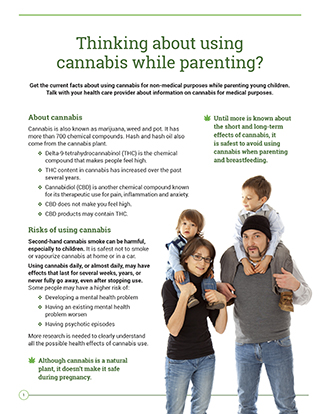Thinking about using cannabis while parenting?

Download the alternative format
(PDF format, 1,992 KB, 5 pages)
Organization: Health Canada
Date published: 2018-10-15
Get the current facts about using cannabis for non-medical purposes while parenting young children. Talk with your health care provider about information on cannabis for medical purposes.
About cannabis
Cannabis is also known as marijuana, weed and pot. It has more than 700 chemical compounds. Hash and hash oil also come from the cannabis plant.
- Delta-9-tetrahydrocannabinol (THC) is the chemical compound that makes people feel high.
- THC content in cannabis has increased over the past several years.
- Cannabidiol (CBD) is another chemical compound known for its therapeutic use for pain, inflammation and anxiety.
- CBD does not make you feel high.
- CBD products may contain THC.
Until more is known about the short and long-term effects of cannabis, it is safest to avoid using cannabis when parenting and breastfeeding.
Risks of using cannabis
Second-hand cannabis smoke can be harmful, especially to children. It is safest not to smoke or vapourize cannabis at home or in a car.
Using cannabis daily, or almost daily, may have effects that last for several weeks, years, or never fully go away, even after stopping use. Some people may have a higher risk of:
- Developing a mental health problem
- Having an existing mental health problem worsen
- Having psychotic episodes
More research is needed to clearly understand all the possible health effects of cannabis use.
Although cannabis is a natural plant, it doesn’t make it safe when parenting.
When parenting
Using cannabis may reduce a person’s ability to pay attention, make decisions or react to emergencies. This can affect how parents respond to a child’s needs and keep them safe. Parents can miss:
- Signs of danger
- Need to be comforted
- Cues for hunger
- Desire to play and learn
Using cannabis may affect parent-child interactions and attachment. The effects of cannabis can last for several hours.
Consuming cannabis in foods or drinks can make people feel higher than expected.
Because the effects are delayed, people may take more cannabis than they had planned.
It is important to be alert and to pay attention to your child’s cues.
Be sure that there is always someone available who is not high to take care of your child.
Caution Advised
Cannabis products like cookies, gummy bears, brownies, lollipops, and shakes can look like a treat to a child.
Keep all cannabis products away from children.
They can be harmful to a child. Watch for:
- Anxiety
- Sleepiness
- Difficulty breathing
- Drowsiness
- Lack of coordination
- Slurred speech
- The signs and symptoms can vary from mild to severe.
- The body has to digest cannabis first to feel the effects, which can take some time.
- A child’s reaction may not be right away, but can show up hours later.
If you think your child ate/drank cannabis, get medical help right away.
Call 911 if your child seems ill or has difficulty breathing.
Be careful about safely storing and using cannabis in front of children.
- Store all cannabis products in a locked area and in child-resistant packaging.
- Make certain a child cannot see or reach the locked area.
- Don’t eat or smoke cannabis products in front of a child.
- Avoid using cannabis while caring for a child.
When driving
Cannabis impairs the ability to operate a motor vehicle safely. Even if you don’t feel high, using cannabis:
- Slows down reaction time and thinking skills.
- Makes it harder to judge distances.
Driving at a slower speed, when using cannabis, does not make it safer for the driver, for passengers and others on the road.
Even a small amount of cannabis distorts your perception.
Cannabis is unsafe when driving.
When breastfeeding
Cannabis passes into the breast milk. It can be stored in your baby’s fat cells and brain for weeks.
- Breastfeeding is the healthiest choice for your baby.
- If you need help to reduce or to stop cannabis use, ask your health care provider about support and services in your region.
If you are unable to stop using cannabis completely, try using less, and less often.
Learn about the effects of cannabis as new information becomes available:
- Cannabis in Canada. Get the facts
- Thinking of using cannabis before or during pregnancy
- Canada’s Lower-Risk Cannabis Use Guidelines (LRCUG)
Acknowledgement: The Public Health Agency of Canada would like to thank Best Start Resource Centre for adapting this resource based on their booklet, “Risks of Cannabis on Fertility, Pregnancy, Breastfeeding and Parenting” (2017). We would also like to thank the parents and experts who provided input into the document.